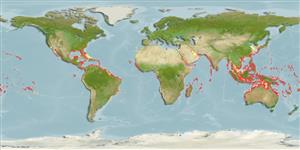Environment: milieu / climate zone / depth range / distribution range
Ecologie
marien rifbewoner; diepte 2 - 50 m (Ref. 9680), usually 3 - 20 m (Ref. 40849). Subtropical; 35°N - 31°S, 180°W - 180°E (Ref. 55213)
Circumtropical. Eastern Pacific: San Diego, California, USA to Chile, including the Galapagos Islands (Ref. 37955). Western Atlantic: Bermuda, Massachusetts (USA), and northern Gulf of Mexico to Brazil (Ref. 7251). Eastern Atlantic: 30°N to 23°S (Ref. 6951). Western Indian Ocean: Red Sea to Madagascar, Reunion and Mauritius (Ref. 33390). The reports in the Mediterranean Sea are doubtful (Ref. 50345).
Grootte / Gewicht / Leeftijd
Maturity: Lm ? range ? - ? cm
Max length : 91.0 cm TL mannelijk / geslacht onbekend; (Ref. 2850); common length : 40.0 cm TL mannelijk / geslacht onbekend; (Ref. 26999); max. gepubliceerd gewicht: 2.8 kg (Ref. 40637)
Dorsale stekels (totaal): 0; Dorsale zachte stralen (totaal): 14-17; Anale stekels 0; Anale zachte stralen: 14 - 16. Body robust; teeth united in each jaw but without a central division; body covered with long, sharp spines, folded backwards when body not inflated; 16 to 20 spines between snout and dorsal fin; dorsal region of caudal peduncle spiny; back, flanks and fins light brown with numerous dark spots; belly spiny (Ref. 55763). Spines long. Body grayish tan, with small black spots, but no large dark blotches. Belly white, surrounded by dusky ring (Ref. 26938). About 20 spines in an approximate row between snout and dorsal fin (Ref. 13442).
Occur in lagoon and seaward reefs to at least 50 m. Commonly seen in caves and holes in shallow reefs (Ref. 26938, 48637). Juveniles to about 20 cm are pelagic. Adults benthic (Ref. 30573). Solitary and nocturnal that feed on hard shelled invertebrates like sea urchins, gastropods, and hermit crabs (Ref. 9680). Generally common (Ref. 9710). Not normally used as food (Ref. 3717). Reached a life-span of 10 years and a length of 69 cm in the McGinty Aquarium (E. Dashiell, pers. comm 2004), suggesting a preliminary K=0.12.
Levenscyclus en paargedrag
Maturiteit | Voortplanting | Paaien | Eieren | Fecunditeit | Larven
Randall, J.E., G.R. Allen and R.C. Steene, 1990. Fishes of the Great Barrier Reef and Coral Sea. University of Hawaii Press, Honolulu, Hawaii. 506 p. (Ref. 2334)
Status op de Rode Lijst van het IUCN (Ref. 130435)
Gevaar voor de mens
Poisonous to eat (Ref. 4690)
Gebruik door de mens
Visserij: van minder commercieel belang; Aquarium: Commercieel
Meer informatie
ReferentiesAquacultuurAquacultuurprofielKweeklijnenGeneticaElectrophoresesErfelijkheidZiektesVerwerkingNutrientsMassaconversie
Tools
Speciale rapporten
Download XML
Internetbronnen
Estimates based on models
Preferred temperature (Ref.
123201): 23.3 - 29, mean 27.4 °C (based on 1822 cells).
Fylogenetische diversiteitsindex (Ref.
82804): PD
50 = 0.5313 [Uniqueness, from 0.5 = low to 2.0 = high].
Bayesian length-weight: a=0.08710 (0.04269 - 0.17770), b=2.76 (2.58 - 2.94), in cm total length, based on LWR estimates for this species & (Sub)family-body (Ref.
93245).
Trofisch niveau (Ref.
69278): 3.7 ±0.0 se; based on diet studies.
Weerstandsvermogen (Ref.
120179): laag, minimale populatieverdubbelingstijd 4,5-14 jaar (tmax>10; preliminary K=0.12).
Fishing Vulnerability (Ref.
59153): High vulnerability (56 of 100).
Nutrients (Ref.
124155): Calcium = 16 [6, 54] mg/100g; Iron = 0.538 [0.255, 1.321] mg/100g; Protein = 19.4 [17.2, 21.6] %; Omega3 = 0.153 [0.078, 0.295] g/100g; Selenium = 23.5 [9.7, 53.9] μg/100g; VitaminA = 15.6 [3.8, 69.9] μg/100g; Zinc = 0.52 [0.33, 0.84] mg/100g (wet weight);
